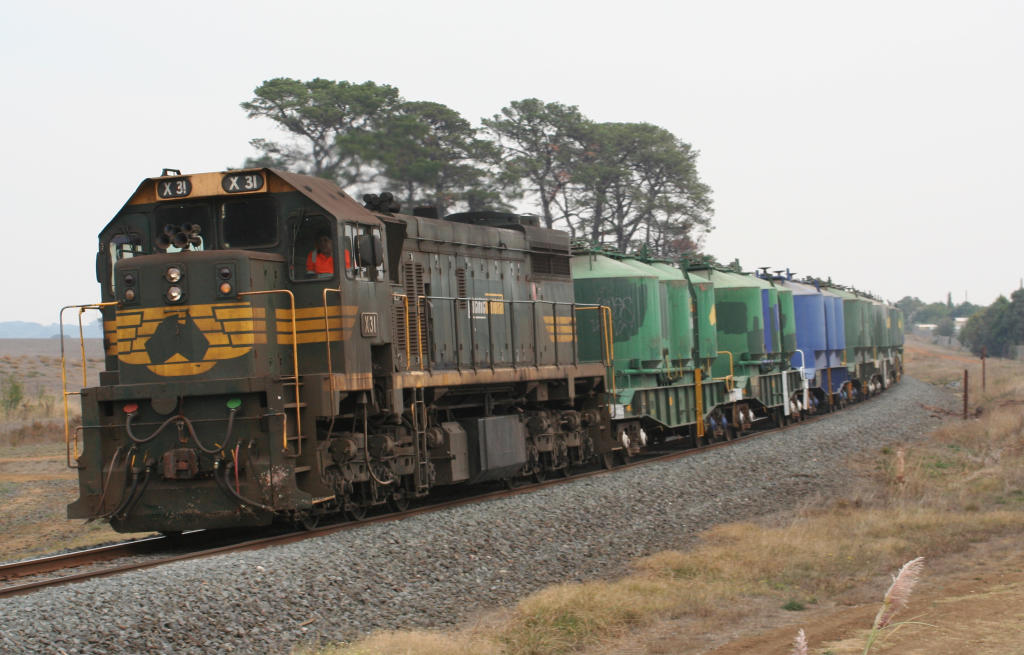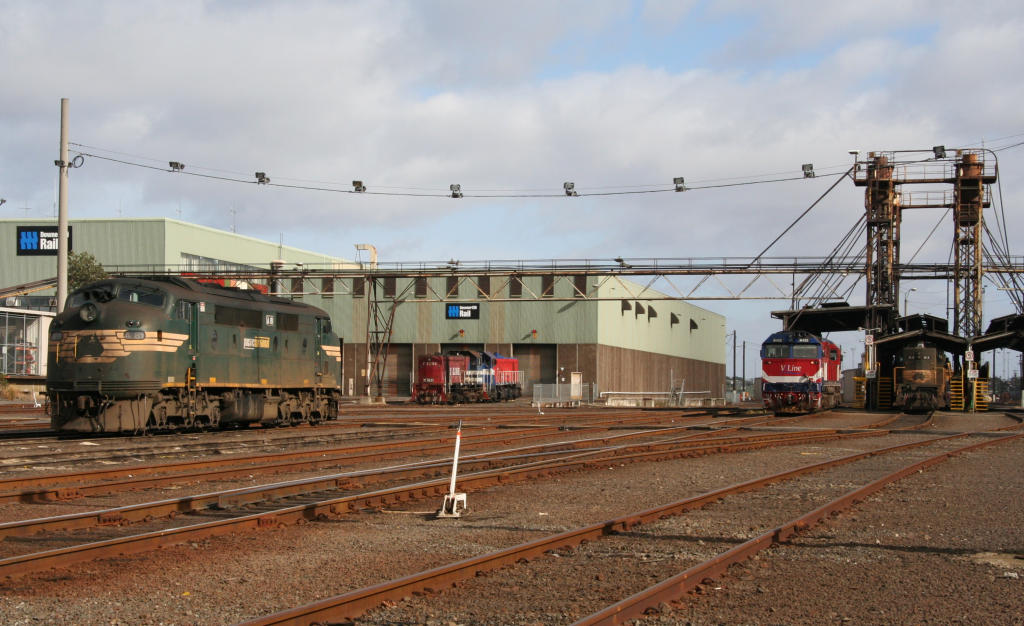|
Freight Australia XR Class
The XR class are a class of diesel locomotives built by Freight Australia and Pacific National at South Dynon Locomotive Depot. History Between 2002 and 2004, Freight Australia rebuilt six X class locomotives with engines cascaded from G class locomotives, larger radiators, and a new cab to provide better driver visibility. The first six (XR550 - XR555) were converted from X38, X35, X40, X33, X34 and X32 respectively. A seventh (XR556) was planned to be converted from X36 but never eventuated. A further three (XR557 - XR559) were built in 2004/05 by Freight Australia's successor, Pacific National, as new-builds. In 2020, several were placed in store due to a poor grain harvest. As at October 2022, all nine were active, seven on the broad gauge and two (XR558 and XR559) on standard gauge. As of November 2023 all are on BG except XR559 Australia Wide Fleet List ''Motive Power'' issue 144 November 2022 page 69 The class are mechanically similar to the later XRB class B unit ... [...More Info...] [...Related Items...] OR: [Wikipedia] [Google] [Baidu] |
Freight Australia
Freight Australia was an Australian railway company that purchased the V/Line Freight business from the Government of Victoria in 1999. Initially known as Freight Victoria, it operated rail freight services and controlled non-urban rail track in the state of Victoria, later expanding into freight haulage in other states. Freight Australia was sold to Pacific National in August 2004. Background V/Line formerly had a freight division, known as V/Line Freight. Under the Kennett State Government, V/Line was split into two separate entities on 1 July 1997: V/Line Passenger and V/Line Freight, with separate management to each other in preparation for privatisation. When V/Line was privatised in 1999, the passenger and freight divisions were sold separately. History Inception The company was formed in March 1999 when the Freight Victoria consortium was announced by the Victorian State Government as the successful bidder for the state owned V/Line Freight business. [...More Info...] [...Related Items...] OR: [Wikipedia] [Google] [Baidu] |
Motive Power
''Motive Power'' is a bi-monthly railway related magazine that focuses on diesel locomotives in Australia. The first issue was published on 23 August 1998. Its headquarters is in Sydney. The content includes photographs of locomotives & trains, news about newly delivered and repainted locomotives, technical articles, and fleet listings of the various Australian railway operators. Articles about railway photography itself are sometimes included, as well as articles and advertisements about railway modelling. Parameters * Size : A4 * Issue : Number 111 is May/June 2017 * Coverage : Australia & some modelling * ISSN : 1442-7079 * Publisher : Motive Power Publications Pty. Ltd. See also * List of railroad-related periodicals A ''list'' is any set of items in a row. List or lists may also refer to: People * List (surname) Organizations * List College, an undergraduate division of the Jewish Theological Seminary of America * SC Germania List, German rugby u ... [...More Info...] [...Related Items...] OR: [Wikipedia] [Google] [Baidu] |
Railway Locomotives Introduced In 2004
Rail transport (also known as train transport) is a means of transport that transfers passengers and goods on wheeled vehicles running on rails, which are incorporated in tracks. In contrast to road transport, where the vehicles run on a prepared flat surface, rail vehicles (rolling stock) are directionally guided by the tracks on which they run. Tracks usually consist of steel rails, installed on sleepers (ties) set in ballast, on which the rolling stock, usually fitted with metal wheels, moves. Other variations are also possible, such as "slab track", in which the rails are fastened to a concrete foundation resting on a prepared subsurface. Rolling stock in a rail transport system generally encounters lower frictional resistance than rubber-tyred road vehicles, so passenger and freight cars (carriages and wagons) can be coupled into longer trains. The operation is carried out by a railway company, providing transport between train stations or freight customer facil ... [...More Info...] [...Related Items...] OR: [Wikipedia] [Google] [Baidu] |
Pacific National Diesel Locomotives
The Pacific Ocean is the largest and deepest of Earth's five oceanic divisions. It extends from the Arctic Ocean in the north to the Southern Ocean (or, depending on definition, to Antarctica) in the south, and is bounded by the continents of Asia and Oceania in the west and the Americas in the east. At in area (as defined with a southern Antarctic border), this largest division of the World Ocean—and, in turn, the hydrosphere—covers about 46% of Earth's water surface and about 32% of its total surface area, larger than Earth's entire land area combined .Pacific Ocean . '' Britannica Concise.'' 2008: Encyclopædia Britannica, Inc. The centers of both the |
Co-Co Locomotives
Co-Co is the wheel arrangement for diesel or electric locomotives with two six-wheeled bogies with all axles powered, with a separate traction motor per axle. The equivalent UIC classification (Europe) for this arrangement is Co′Co′, or C-C for AAR (North America). Use Co-Cos are most suited to freight work as the extra wheels give them good traction. They are also popular because the greater number of axles results in a lower axle load to the track. History The first mainline diesel-electric locomotives were of Bo-Bo arrangement. As they grew in power and weight, from 1937 the EMD E-units used an A1A-A1A layout with six axles to reduce axle load, but only four of them were powered. After WWII, the British LMS ordered two prototype locomotives with some of the first Co-Co arrangements. The first C-C design recorded was a narrow-gauge Hornsby opposed-piston Hornsby-Akroyd-engined locomotive of 1903 for the Chattenden and Upnor Railway. There was a two-speed mec ... [...More Info...] [...Related Items...] OR: [Wikipedia] [Google] [Baidu] |
Broad Gauge Locomotives In Australia
Broad(s) or The Broad(s) may refer to: People * A slang term for a woman. * Broad (surname), a surname Places * Broad Peak, on the border between Pakistan and China, the 12th highest mountain on Earth * The Broads, a network of mostly navigable rivers and lakes in the English counties of Norfolk and Suffolk, United Kingdom **The Broads include several areas of navigable water known as Broads; the largest is Hickling Broad (see :Norfolk Broads) * The Broads (New Hampshire), a wide portion of Lake Winnipesaukee in Belknap County, New Hampshire, United States * Broad Bay (other) * Broad Canal, East Cambridge, Massachusetts, United States * Broad Channel, a neighborhood in Queens, United States * Broad Crag, a fell in the English Lake District, United Kingdom * Broad Creek (other) * Broad River (other) * Broad Run (other) * Broad Sound (other) * Broad Valley, Graham Land, Antarctica * Broad Water, a salt water lagoon near Tywyn ... [...More Info...] [...Related Items...] OR: [Wikipedia] [Google] [Baidu] |
B Unit
B, or b, is the second letter of the Latin-script alphabet, used in the modern English alphabet, the alphabets of other western European languages and others worldwide. Its name in English is '' bee'' (pronounced ), plural ''bees''. It represents the voiced bilabial stop in many languages, including English. In some other languages, it is used to represent other bilabial consonants. History Old English was originally written in runes, whose equivalent letter was beorc , meaning "birch". Beorc dates to at least the 2nd-century Elder Futhark, which is now thought to have derived from the Old Italic alphabets' either directly or via Latin . The uncial and half-uncial introduced by the Gregorian and Irish missions gradually developed into the Insular scripts' . These Old English Latin alphabets supplanted the earlier runes, whose use was fully banned under King Canute in the early 11th century. The Norman Conquest popularised the Carolingian half-uncial forms which lat ... [...More Info...] [...Related Items...] OR: [Wikipedia] [Google] [Baidu] |
Pacific National XRB Class
The XRB class are a class of cabless diesel locomotives built by Pacific National in 2005–2006. History The XRB class were built by Pacific National at their South Dynon workshops. They are mechanically similar to XR class locomotives, but are B unit B, or b, is the second letter of the Latin-script alphabet, used in the modern English alphabet, the alphabets of other western European languages and others worldwide. Its name in English is ''bee'' (pronounced ), plural ''bees''. It re ...s without driving cabs. XRB locomotives are designed to be used as booster units on standard gauge interstate freight trains, and must be led by a locomotive with a conventional driving cab. The units do not have hostler controls for moving them around yards and depots, only being fitted with a dead engine device and park-brake button. All three class members are currently stored at the Port Augusta Workshops. Status table References Co-Co locomotives Locomotives with ca ... [...More Info...] [...Related Items...] OR: [Wikipedia] [Google] [Baidu] |
Newsrail
''Newsrail'' is a monthly railway magazine covering the railways and tramways of Victoria, Australia. It was launched in January 1973 by the Australian Railway Historical Society The Australian Railway Historical Society (ARHS) aims to foster an interest in the railways, and record and preserve many facets of railway operations. It had divisions in every state and the Australian Capital Territory, although the ACT divis ...'s Victorian Division, superseding the ''Divisional Diary'' title that had been published by the society since November 1957. Since May 2020, it has been published by Victorian Rail Publishing Inc. Details * Issue December 2019 is Vol 47 No. 12. * Period = monthly * Size = 245 mm (H) by 170 mm (W) (to Dec 1991), A4 (from Jan 1992) References External linksOfficial website Magazines established in 1973 Magazines published in Melbourne Monthly magazines published in Australia Rail transport magazines published in Australia 1973 establishments in Au ... [...More Info...] [...Related Items...] OR: [Wikipedia] [Google] [Baidu] |
South Dynon Locomotive Depot
South Dynon Locomotive Depot is an Australian locomotive depot in Melbourne, purpose built for the servicing of diesel and electric locomotives by the Victorian Railways opening in July 1961. It was built adjacent to the Dynon marshalling yards. It has two separate turntables for stabling broad and standard gauge locomotives. It was included in the sale of V/Line Freight to Freight Victoria in May 1999, however has remained a VicTrack Asset, and the lease passed to Pacific National Pacific National is one of Australia's largest rail freight businesses. History In February 2002, National Rail Corporation, National Rail's freight operations and rollingstock (owned by the Government of Australia, Federal, Government of New ... upon its acquisition of Freight Australia in August 2004. Downer EDi Rail operated roads 5 to 11 of the facility as part of a Victorian Locomotive fleet maintenance contract with Pacific National (PN) which ran from September 2008 until June 2016. Th ... [...More Info...] [...Related Items...] OR: [Wikipedia] [Google] [Baidu] |
Railway Digest
''Railway Digest'' is a monthly magazine, published in Sydney, covering contemporary railways of Australia. Overview The magazine's publisher is the Australian Railway Historical Society (ARHS), NSW Division. The first issue was published in March 1963 under the name ''New South Wales Digest'' and regular publication commenced with the May 1963 edition. It was renamed in January 1983. In January 1985 it changed paper size from SRA5 to A4. Originally an enthusiast magazine mainly focusing on reporting day-to-day workings of the New South Wales Government Railways and it successors, it was produced by volunteers using a hand-operated duplicator at the home of one of its members. In May 1993, a paid editor was appointed and the magazine's focus gradually shifted to reporting news from across Australia. It has evolved into a professional full-colour production directed at the wider community and commercially distributed to newsagents throughout Australia."Adapt or disappear - the ... [...More Info...] [...Related Items...] OR: [Wikipedia] [Google] [Baidu] |

.jpg)

